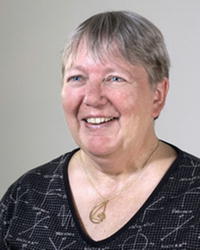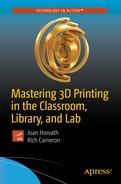
To the open source community, particularly to contributors to the RepRap Project, whose vision made consumer 3D printing a reality
It has only been four years since the original 2014 Mastering 3D Printing went to press. In the intervening years, the field has exploded so much that we are to focusing this book on the needs of the educational and scientific markets. Printers have dropped in price down to a few hundred dollars for a basic model and a few thousand for a fairly sophisticated one. Yet adoption has been remarkably slow in education, and we hope to change that.
This book focuses on consumer-level printers and their applications in the educational and scientific environments. We focus primarily on 3D printers that create objects by melting plastic filament, but also include a little about printers that use liquid resin.
3D printing can be defined pretty simply: creating an object by building it up layer by layer, rather than machining it away the way you would by making something from a block of wood, or by squirting something into a mold as you would for injection-molded plastic parts. Its flexibility and the sheer magic of seeing something built from nothing have captured people’s imaginations, and it is clear that surprising applications will continue to pop up for years to come.
This book is intended for several audiences. It is meant to be a self-contained tutorial on consumer 3D printers and the open source software that runs them, particularly for educators who are trying to set up or run a school makerspace or librarians who are trying to figure out what to do about a mandate to buy printers or create a community space.
Although we say the book is for “classroom, library, and lab,” a broader audience will find the core information helpful. If you are not an educator and want to focus on the 3D printing per se, Chapters 1 – 6 apply to anyone’s use of consumer-level printers; Chapter 8 gives a lot of information on post-processing prints to make them look good; and Chapter 9 discusses making prints as strong as possible. The examples in the other chapters, although primarily classroom oriented, may inspire you for your projects as well.
This book also is intended to be used as a text for a semester-length class or university extension course series covering 3D printing, its applications, and its place in education. It might be paired with an in-depth class on 3D computer-aided design (CAD) software for students interested in teaching engineering and industrial or product design. Similarly, it might be paired with instruction in one of the sculptural 3D-modeling programs for students developing skills in 3D animation or fine art.
Part I (Chapters 1 – 3 ) of the book gives background on the history of 3D printers, talks about how the hardware and software work, discusses available materials, and gives some detail of the 3D-printing workflow.
Part II (Chapters 4 – 6 ) reviews how to decide what kind of printer you need to buy, based on what you want to build with it and what materials you think you will want to be able to use. This part also reviews what kinds of facilities different 3D printers require, and the hands-on details of dealing with issues that might arise during a print. Finally, this part reviews options you can use to create 3D-printable model files.
Part III (Chapters 7 – 12 ) discusses the classroom use of 3D printing in different subject disciplines, with a particular focus on K–12. We start off with a brief introduction to common issues in classroom 3D printing, and then look at art and theater concerns, considering print post-processing topics like gluing, sanding, and painting, as well as a bit about casting jewlery. We also consider engineering concerns, like making a print strong enough for a functional job. Next, we take up using printers in language arts and social studies, and in the elementary school environment. Finally, we talk about how 3D prints might help special-needs students, particularly the visually impaired.
Finally, in Part IV (Chapters 13 and 14 ), we discuss university and community uses of 3D printing and how to think about careers in 3D printing in the near and long term. Chapter 13 focuses on research into both applications of 3D printing and technology development for 3D printers per se. Chapter 14 winds up the book with a discussion of the opportunities and challenges for teaching entrepreneurship, and tries to predict where the manufacturing and other applications of the technology are likely to be in the near and longer term.
We also include an appendix, in which we have gathered all the links from the book, plus a few news sources that cover the 3D printing world and some books that might provide other places to explore.
Librarians will likely find Chapters 1 – 6 and 13 – 14 the most useful, although the materials in Chapters 7 – 12 may suggest community projects.
The field is still evolving. As in the 2014 Mastering 3D Printing, we have avoided detailed descriptions of software packages. We stick with descriptions that will let you get started but will not be wrong three months after publication. We like to say that 3D printing is about as complex as cooking. In cooking terms, you will find that this book has a bias away from providing recipes to follow exactly and instead leans toward teaching you how to cook using your own judgement for the long haul.
If you are just starting your exploration of the field, welcome. Hopefully this book will be a good guide for you, and you will finish it ready to take on challenges and try to help build this new frontier along with us.
The consumer 3D-printing ecosystem would not exist in its current form without the open source 3D-printing hardware and software community. The maker community as a whole has also been very supportive. We appreciate how much we learn by looking at projects made by everyone at maker events large and small.
The Apress production team was there for us to solve problems as they arose and let us have great creative freedom otherwise. We dealt most directly with Natalie Pao, Jessica Vakili, Corbin Collins, and Welmoed Spahr, but we also appreciate the many we did not see. This book includes some materials from our other Apress 3D-printing titles, notably the 2014 Mastering 3D Printing and the 2016 and 2017 3D Printed Science Projects books.
We talked to many 3D-printing professionals and maker-educators to develop this book and we are grateful for the advice, images, and in some cases permission to use screenshots or photographs of their work, which is credited in more detail in the text. On the 3D-printing side of the family, we want to particularly call out Steve Wygant of SeeMeCNC; Shelley Sun and Russell Singer of MAKEiT, Inc.; Mara Hitner and Dave Gaylord at MatterHackers; Diego Porqueras of Deezmaker; Marius Kintel and the other OpenSCAD developers; the teams at Ultimaker and Formlabs; and Thatcher Chamberlain, Metalnat Hayes, Giovanni Salinas, and David Shorey.
Educators (and their students) who particularly inspired us were Simon Huss, Regina Rubio, Tri Nguyen, Karalyn Ramon, and others at the Windward School; Dori Friedman and Paul Way of Crossroads School; Omeed Shahhosseini and Will Kalman, Granada Hills Charter High School, and maker-educators John Umekubo, Lucie deLaBruere, and Rodney Batschelet. We were inspired to create 3D-printable educational models for visually impaired students by discussions with people in the community of teachers of the visually impaired, notably Mike Cheverie, Lore Schindler, Yue-Ting Siu, and Jim Allan. We have spoken to quite a few librarians to understand their issues and are particularly grateful to Vivienne Bird, Los Angeles Public Library, and Michael Pierce and his colleagues at the Pasadena Public Library.
Finally, we are grateful to our families for putting up with our endless brainstorming and test runs of explanations, particularly Joan’s husband Stephen Unwin, Rich’s sister, Rachel Cameron, and Diamond the Wonder Puppy.
Table of Contents
About the Authors
are the cofounders of Nonscriptum LLC, based in Pasadena, California. Nonscriptum consults for educational and scientific users in the areas of 3D printing and maker technologies. Joan and Rich find ways to use maker tech to teach science and math in a hands-on way, and want to make scientific research cheaper and more accessible to the public.
This book is their seventh collaboration for Apress. They teach online classes in 3D printing and maker tech for LERN Network’s U Got Class continuing education program. They have also authored online courses for LinkedInLearning/Lynda.com. Links for all of the above are on their website, www.nonscriptum.com .
In addition to her work with Rich, Joan also has an appointment as adjunct faculty for National University’s College of Letters and Sciences. She has taught at the university level in a variety of institutions, both in Southern California and online. Before she and Rich started Nonscriptum, she held a variety of entrepreneurial positions, including VP of business development at a Kickstarter-funded 3D-printer company.

Joan started her career with 16 years at the NASA/Caltech Jet Propulsion Laboratory, where she worked in programs including the technology transfer office, the Magellan spacecraft to Venus, and the TOPEX/Poseidon oceanography spacecraft. She holds an undergraduate degree from MIT in aeronautics and astronautics and a master’s degree in engineering from UCLA.
Rich (known online as “Whosawhatsis”) is an experienced open source developer who has been a key member of the RepRap 3D-printer development community for many years. His designs include the original spring/lever extruder mechanism used on many 3D printers, the RepRap Wallace, and the Deezmaker Bukito portable 3D printer. By building and modifying several of the early open source 3D printers to wrestle unprecedented performance out of them, he has become an expert at maximizing the print quality of filament-based printers. When he’s not busy making every aspect of his own 3D printers better, from slicing software to firmware and hardware, he likes to share that knowledge and experience online so that he can help make everyone else’s printers better too.

